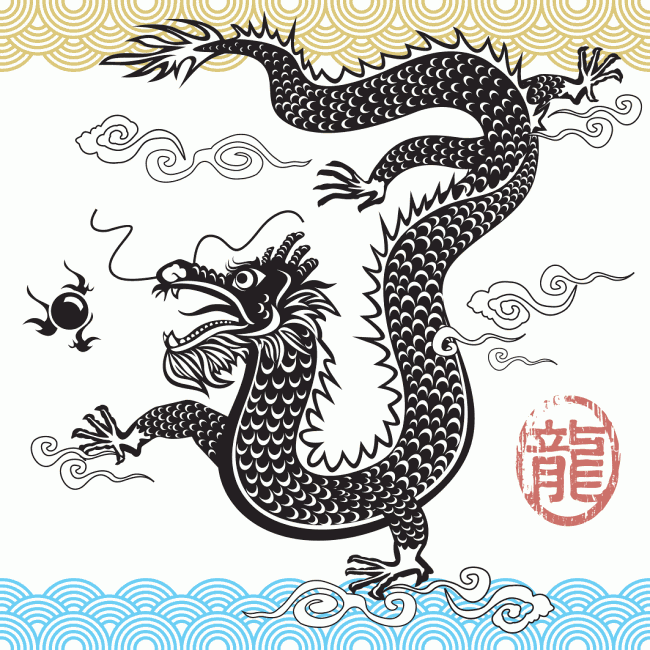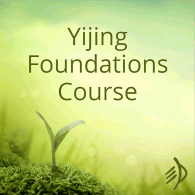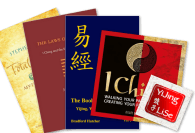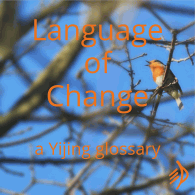The second chapter of David Pankenier’s lovely book, Astrology and Cosmology in Early China – Conforming Earth to Heaven – rejoices in the title, ‘Watching for dragons.’ In it he talks in detail about the dragon of Hexagram 1, and also proposes a whole new idea about why the dragons are fighting in 2.6.
For a long time (since 1930 in the West and earlier than that in China), the scholarly consensus has been that Hexagram 1 describes the Cerulean Dragon. This was a vast constellation whose journey across the sky described the growing season in old China. Of course, the dragon is not only in the sky; rain dragons also sleep in mountain lakes and must be woken at the right time in spring, as Steve Marshall wrote in The Mandate of Heaven. Also, Chinese alligators had remarkably dragon-like seasonal habits, and alligator-skin drums were the preferred way of imitating thunder and inviting rain. But the dragon that flies in the heavens is made of stars.
You can see illustrations of its flight in Pankenier’s book (page 49). It’s invisible in winter, in the watery abyss under the earth (‘submerged dragon’, line 1). In spring, its horn appears above the horizon at dusk, and you gather to conduct a great rain sacrifice in the month before the summer solstice (line 2 zhi 13). (Pankenier thinks line 3 isn’t part of the story, but wouldn’t farmers now have to work hard all day and still watch the sky at nightfall to check the dragon’s position?) The whole body of the dragon becomes visible, climbing vertically into the sky (‘dancing’ or ‘leaping’ in line 4), and levels off and soars over the fields in summer, spanning the sky (line 5). By mid-August, its horn is already dipping below the horizon again.
(Pankenier suggests that the dragon of 1.6 seems to be lingering too long or too high because the lunar month and stellar calendar have fallen out of sync – as they do, over time – and we need to interpose an intercalary thirteenth month to restore order. This would necessitate rethinking the translation a bit: not ‘an overweening dragon has regrets’ but ‘the dragon rising high, there will be regret.’ It doesn’t have to be the dragon who experiences regret; it could be the people who realise from this sign that their farming is not in harmony with the seasons.)
This dragon is an unmistakable, unfailing sign of when to work and when to rest – of how to ‘conform earth to heaven’ and bring the rhythm of your own life into harmony with the celestial power. For modern Westerners talk of being ‘in harmony with heaven’ or ‘in dao‘ can sound either esoteric, or a rather fluffy abstraction. But ‘riding the dragon’ is utterly different: you must plant and work at the right time; if you are too early or too late, your crops won’t grow and you won’t eat.
So the dragon belongs with Hexagram 1, the Creative, Heaven, as an active, celestial creature, bringer of growth and sign of the coming of summer.
Only… the dragon also appears in hexagram 2, line 6:
‘Dragons battling in the open country.
Their blood dark and yellow.’
…and hexagram 2 is associated with winter: Stephen Field describes it as ‘a “works and days” that narrates the agricultural activities of fall and winter,’ beginning with frost underfoot in line 1 as a sharp reminder that it’s time to prepare.
So why are there dragons fighting in hexagram 2 – and why would they appear there in the first place?
In my book I suggested that one of the dragons was fighting for the earth quality of openness to all possibilities – to the point of ‘sheer inertia, resisting the creative impulse that would give a new and specific shape to things.’ (I also unfortunately betrayed my ignorance by calling it an ‘earth dragon’… ah, well…)
Well… dragons are not just heavenly creatures; they’re also water creatures, followed by clouds as they rise from and return to the watery abyss under the earth. And the celestial Dragon actually doesn’t disappear throughout the winter. Pankenier:
‘As any ancient farmer or sky-watcher certainly knew, the Dragon never disappeared from the sky during the season of cold and darkness, much as the yin force never completely overcomes the yang.’
Rather, the dragon would disappear below the horizon by September, but its horns would re-emerge above the Eastern horizon by mid-October, in the hours before dawn (as opposed to the spring/summer dragon who’s first seen at dusk).
‘After this, the Dragon, rising almost vertically, would follow the same soaring path across the heavens as in spring and summer, only in half the time.’
And this means that come February,
‘the Dragon’s horn Spica would reappear above the eastern horizon at dusk while a second Dragon could still be seen in the western sky on the very same day late at night until dawn. Given the appearance of differently postured Dragons in both predawn and evening skies at the start of the New Year, it follows that two Dragons would have been thought to coexist at the margins of the sky, one yin and one yang, contending with each other for supremacy.’
So the dragons fight: one for the persistence of winter stillness, the other for the return of spring.
In my book I drew on experience to suggest that one of the dragons was fighting for the earth quality of openness to all possibilities – to the point of ‘sheer inertia, resisting the creative impulse that would give a new and specific shape to things.’ (I also unfortunately betrayed embarrassing ignorance by calling it an ‘earth dragon’… ah, well…) These celestial dragons seem to fit the same idea: if the winter-dragon won (calling it a yin dragon as Pankenier does is anachronistic), the earth would stay quiet and open, spring would not come and nothing would grow. Quiescent potential vs active growth: in practice, 2.6 can mean someone is digging in her heels against changing times, against having something definite happen.
I find the zhi gua (23) and fan yao (23.6) of this line pretty interesting too. 23 is Stripping Away, the last of the old solid lines leaving the field of open lines. It’d be hard to talk about this in readings without mentioning clearing the ground for planting – which is also an agricultural task for the cusp of spring.
And the fan yao:
The difference between noble one and small people parallels the conflict between the two dragons. One is forward-looking, one is not; one moves, one stays put. (You would have spent winter shut up in your hut, using up your food stores – but it’s time to come out.)
What about the ripe fruit uneaten, that contains the seed of potential for future growth? Well… here’s Pankenier again:
‘The first achronycal (evening) rising of the dragon’s horn above the Eastern horizon, “in the fields”, accompanied by the first full moon of Spring (the pearl the dragon is often depicted chasing or mouthing), signalled the quickening of vegetative life and the approach of spring planting.’
Could the uneaten fruit be this first full moon?

It’s about to be spring; everything is preparing to grow. Where are you? Travelling with the change, or fighting it?
Tracing this line pathway all the way round takes us full circle back to autumn:
Their blood dark and yellow.’
Noble one gets a cart,
Small people strip their huts.’
No regrets here.
From the source, good fortune.’
Hard ice is arriving.’
Now it’s time to find a partner and move into your hut for the winter. The pathway overall isn’t about a single time of year, but rather the moment – spring or autumn – when a new season is ‘not far away, returning’, and it’s time to respond and move.











I would have mentioned the part in this book – pages 69 to 80 – where Pankenier mentioned the alligator as a possible inspiration for the people back in 2300 BCE to the Dragon in the I Ching to HeyLise who posted such a theory some years ago. I searched here on Onlineclarity for Alligator but didn’t reach her posting. And I was logged in when searching.
I’ve laid an excerpt up here: https://svenrus.dk/alligator_dragon_pankenier.pdf
Can You tell me how to find the thread in wich HeyLise mentioned the Alligator as a possible ideal for the Dragon?
Sven Christensen (surnevs in this forum)
Here is LiSe’s own page about the alligator-dragon, and here’s the forum thread where we discussed the idea.
Hilary, thank you. Your explanations are so very helpful. I have been getting the 23rd hexagram over and over in readings for weeks now. I was mystified by 2.6. I’m in a much better state of understanding after having read your thoughts on this and see why the oracle keeps sending this message. Many thanks.
Ooofff… weeks of 23 can’t have been any fun. I’m glad I could help.
Wonderful explanation!
Thank you. This clear explanation has helped me with this issue in dreams for my book Dragon Dreams
Q. Why did our new party not succeed in our local politics (we didn’t want to be a national political party, but coalition of independent residents) All my yi readings were supportive
A. One of our (hidden) opponents was a Feng Shui master, & Dragon year of birth. The other the dominant party with yellow(!) we met the local political furies, personal hit jobs, etc.
Yes, maybe inertia too as a result. I suspect this is not a good interpretation, but i do wonder about how powers of these masters is used ( personally i found a bit malign)